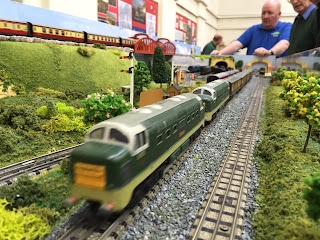A chance conversation during a visit to a model railway shop to buy wagons (when I was doing the "Paint your wagons" series) led to an exchange of emails, and then another offer to exhibit!
Southampton, Millbrook to be exact, is the furthest we've travelled so far. With the extra distance in mind, we opted for a Saturday morning arrival and setup. Now I'm by no means a fan of early morning setups, the track is old and can give problems but thankfully went together in no time and ran without fault...
...until about lunchtime on the first day!
A dead short appeared along the front of the layout. Probably the only downside of removing all those points is that I've now lost the opportunity to isolate sections of the layout, which made fault diagnosis much simpler. In the end, the only way to narrow down where the fault was, was to actually separate the boards - not easy to do once fully setup with the curtains in place, and certainly not easy when the exhibition is open!
After establishing which board was faulty, it was then easier to locate. The ammeters, while they look really fancy and ott, really prove their worth in a situation like this and makes fault tracing far easier. If you're considering building any layout, factor in some ammeters - it will save you time and may save you a few burnt out locos, even controllers!
Anyway, after checking the track, a warm spot was noted, the track had become notably hot in one section and this was the location of the short. Sadly I hadn't packed any track on the first day, so after establishing that the centre rail was resting on the tinplate at the joint, it was quickly bent back into shape with pliers and swiftly replaced the following day.
That wasn't to be the end of the track problems - a dead spot then appeared on the outer loop just after the station platform (yep, in the tunnel!) so a quick soldering job was required to sort this one out.
It's fair to say that doing three, weekend-long shows in such a short space of time had raised concerns, firstly how many locos would come home knackered after so much use and secondly, would I get fed up with running the layout? - Thankfully having completed the three shows, the casualty list has only one entry. It would have been more but several were repaired swiftly during the weekend but City of Birmingham is the casualty this time, having slowed to a stop and showing no signs of life and no power consumption.
My recent "Scrapheap challenge" 0-6-2 tank was showing some signs of fatigue during the last outing two weeks ago and this weekend, it refused to run, tripping the controller and showing a dead-short. Fearing that my home-spun armature had failed, I removed the body to find that the exposed wire around the interference suppressor had been touching the body. A quick bend into place and off it went again - phew!
Duchess of Atholl also made a return this weekend - I hadn't had a chance to repair it so during a quiet period on Saturday I took a closer look and found that only one connecting pin had come out. This was re-secured and although the ex-Duchess of Rutland chassis sways a fair bit, it ran reasonable well, albeit at a more gentle pace than normal!
The recently converted Wrenn 8F proved to be a disappointment, being barely able to haul more than itself and flatly refusing to double-head with the other 8Fs. I suspect the issue is either the plastic tender wheels and / or too much spring tension in the plunger pickups. I'll experiment with the tender from 48158 - the loco in need of cosmetic attention, I haven't given up yet.
I also finally got all eight of the fiddle yard sidings to operate properly, running in and out of both inner and outer sidings all weekend, where previously only some of the inner ones worked. I also managed to carry out a loco exchange from the turntable into the inner fiddle yard - the first time that this move as successfully been completed.
As we were a little further afield, we attracted visitors who hadn't seen us before. Again we've had plenty of great feedback and at least four offers to exhibit elsewhere during 2016 and 2017. We're certainly going to be busy next year, and the year after!
4 o'clock came around very quickly on Sunday and then it was all over and time to go home.
Nice to get the layout fully working at last - all the recent modifications and tweaks have really paid off and the reliability gets better and better. The track short issue is a concern and I may have to rethink the 37pin "breakout" connectors between the boards. Although it makes setup quick and easy, it's not easy to disconnect in a fault situation. Either I need to revert to cabled connections or install some additional switches in the boards.
Our thanks to Ron Lines and the Solent Model Railway Group for their hospitality and some mighty fine cakes!
Some limited pictures to follow, once they've uploaded!




























